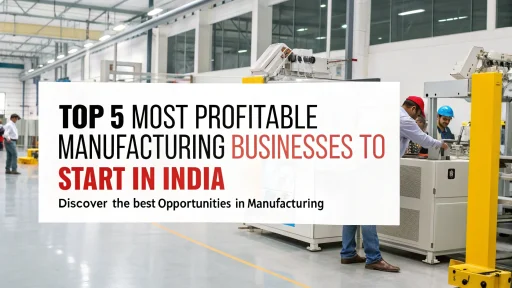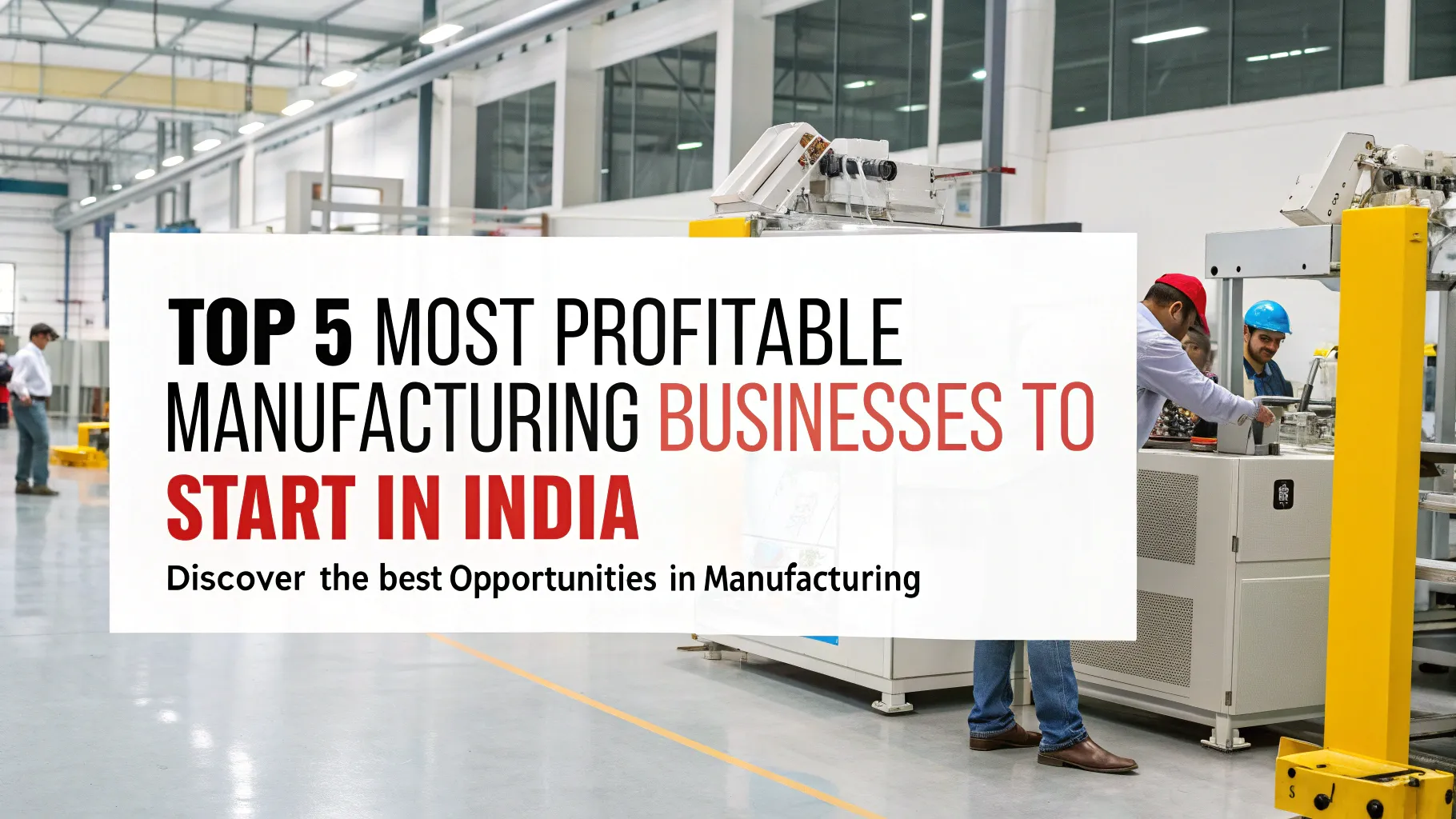The most profitable manufacturing businesses in India are growing rapidly due to increasing domestic consumption, rising exports, and the government’s support for small and medium-sized enterprises. With relatively low barriers to entry and an increasing demand for locally produced goods, small-scale production is one of the best ways to build a long-term and successful business.
If you’re considering starting a most profitable manufacturing business that requires minimal investment, but offers great margins and long-term prospects, manufacturing is the best option. The following article examines some of the top manufacturing ventures emerging in India today, each founded on solid market trends and offering entrepreneurs the opportunity to expand their businesses.
1. Agarbatti and Dhoop Stick Manufacturing
Agarbatti (incense sticks) production isn’t just an old-fashioned business. It is a field that is closely linked to India’s religious and cultural practices. From temples and homes to wellness centres and even export markets, the demand for incense products continues to increase rapidly.
This business concept is easy and affordable. With raw materials such as charcoal powder, bamboo sticks, and essential oils readily available in the local market, business owners can start on a small scale and expand later. Equipment for drying and rolling agarbattis can be rented, and hand-made production is still a viable option for home-based and artisan setups as well as those that employ a skilled worker.
One of the greatest advantages is the wide variety within the range of products: herbal agarbattis, floral blends, ayurvedic scents and even formulas for temples. There is also an increasing demand for international products from nations like the US, UK, UAE and Australia, where communities of Indian origin are seeking high-quality spiritual products.
Profit margins can be appealing, particularly when the products are properly packaged and sold with a distinct brand. Production costs are at a low level, whereas brands can fetch three times the cost of the base product on the export and domestic markets. Government schemes such as SFURTI also offer infrastructure and financial support for traditional agarbatti clusters.
Related: Start Your Profitable Agarbatti Business with Low Investment
2. Eco-Friendly Paper Bags and Sustainable Packaging
As India continues to ban single-use plastics and advocates for sustainable growth, demand for compostable paper-based packaging is growing quickly. Restaurants, supermarkets, clothing stores, and online retailers are constantly substituting plastic bags with sustainable alternatives, resulting in a huge demand for packaging made of paper, boxes and cartons.
This industry is particularly lucrative due to the fact that raw materials are readily accessible and recyclable. Even the simplest semi-automatic machines can make hundreds of units in an hour. Branding or logo printing can add huge value to the finished product.
What makes this sector particularly promising is the shift in perception—sustainability is no longer an option but a necessity for retailers. From FMCG businesses to food delivery companies, there is a real and increasing need. Most Profitable Manufacturing Businesses that can provide high-quality products, speedy delivery and customisation can quickly create B2B contracts with local companies or online vendors.
Additionally, packaging is increasingly an advertising tool. Most Profitable Manufacturing Businesses are increasingly looking to have their brand, logo, and style reflected on their delivery bags or gift boxes. Business owners who can meet these needs and offer design and manufacturing in a bundle are able to earn much more than simply through large-scale sales.
3. Spice Processing and Value-Added Masala Products
India has always been a land of spices—both in cultivation and consumption. With each Indian family using spices daily and the worldwide market for Indian masalas steadily increasing, the sector is an unending opportunity.
What makes this business so profitable is its added value. Raw coriander, turmeric, or chili can be sold for 50 cents per kilogram in wholesale markets. However, when they are cleaned, ground to make masala mixtures and then attractively packed, the cost could increase by 300–500 percent. This is the value that small companies can profit from.
Small-scale spice units are able to be established with just a little space and expense. It is important to ensure hygiene, flavor integrity, and high-quality packaging. Vacuum sealing and moisture-resistant packaging can extend shelf life and ensure that customers return. Consumers are becoming more conscious of adulteration in bulk spices; therefore, brands that guarantee purity and small-batch production stand out.
Furthermore, there’s a lot of potential for regional masalas—be they Chettinad masala, Bengali panchphoron, or Rajasthani masala mix. These unique spice blends, when properly branded, have proven to be major earners on e-commerce platforms. It is possible to make gift bundles, combo sets, and subscription models that will attract loyal customers.
The potential for exports is also positive. Global consumers and NRIs are searching for genuine, high-end Indian spice mixes that taste just like home. By partnering with FSSAI-approved suppliers and using proper labeling and barcoding, smaller spice companies can enter the international market as well.
Related: Spice Trade: History, Tech & Quality Standards in One Volume
4. Detergent, Liquid Cleaner, and Hygiene Product Manufacturing
Hygiene and cleanliness have taken center stage in the Indian consumer’s mind post-COVID. From detergent powders to liquid handwashes, to toilet and floor cleaners, the demand for all-purpose cleaning products has risen in urban, semi-urban, as well as rural markets.
In contrast to FMCG giants, smaller producers have the benefit of being more flexible. They can develop niche products like herbal cleaners, inexpensive small-scale packs for rural areas, refill pouches or natural disinfectants that meet the needs of specific customers. The formulations for these products aren’t too complicated and can be learned through basic industrial training or purchased from consultants.
With a low cost for raw materials and a broad range of products, this is a great option for those seeking a high-volume, high-margin enterprise. Even with a simple mixing and filling configuration, a small-sized unit can create several SKUs with minimal staff. Large buyers such as hospitals, schools, clinics, and factories are also more likely to purchase from local vendors due to convenience and speed.
Branding is a crucial factor. If your packaging is well-designed, practical, and reliable, and the scent and foam are consistently good, you can establish a solid customer base. Rural penetration, hospital supply contracts, and B2B deals with institutional customers can take your company from ₹5 lakhs a month up to ₹50 million per year.
5. Ready-to-Eat (RTE) Snacks and Packaged Foods
As the pace of life in cities increases, families are turning to convenience food options that are fast, nutritious and readily available. This includes snacks that are dry, ready-to-cook meals, instant mixes, frozen parathas and microwave-friendly curries. In India’s diverse cuisine, regional brands selling traditional packaged food are seeing enormous success both online and offline.
RTE manufacturing has proven extremely profitable as it allows for automation, a longer shelf life, and more scale. Traditional food items like thepla, khakhra, poha mix or besan ladoos can be transformed into branded products using vacuum-sealed or nitrogen-packed pouches. They ensure freshness for weeks or even months and help with logistics.
The key lies in quality and emotion. Consumers aren’t buying just food—they’re buying convenience, nostalgia, and confidence. If your product feels genuine and looks appealing, customers will return. Brands such as Haldiram’s, iD Fresh, and Gits started small but quickly grew because of consistent quality and smart distribution.
E-commerce has opened up a wide market. Small companies can sell their products on Amazon, Flipkart, BigBasket or even develop their own D2C brands through Shopify. Festival food kits, seasonal offerings, and health-focused alternatives like millet-based sweets or sugar-free snacks are trending. Export opportunities are also extremely strong, especially for the Indian diaspora market.
With just 200 square feet of space, basic kitchen equipment, and FSSAI registration, one could start a serious food Most Profitable Manufacturing Businesses in today’s India. Margins can range from 35% to 60% depending on ingredients, shelf life, and branding.
For more information watch related video about this article
Final Thoughts: Choosing the Right Manufacturing Business
Each one of the businesses discussed is profitable and viable. However, your success will depend on your strengths—whether that’s product development, sourcing, branding, or sales. What ties these ideas together is their ability to serve consistent consumer needs, allow for small-scale entry, and offer the potential to build a brand over time.
Start with thorough research, ensure quality from day one, and focus on building trust. Branding and packaging are just as important as the product itself. You don’t need a factory to start—a clean space, a few machines, and a great story are often enough.
How NPCS Can Help You Begin Strong
NIIR Project Consultancy Services (NPCS) helps aspiring entrepreneurs transform their Most Profitable Manufacturing Businesses. Their Techno-Economic Feasibility Reports provide detailed advice on market demand, sources of raw materials, process technology, machinery layout, and regulatory requirements.
If you’re planning to set up a spice plant or a paper bag unit, NPCS offers customized support to help reduce risks and improve every step of planning and implementation.
With their knowledge, you can make better decisions and develop companies that are not just profitable, but also scalable and long-lasting.







